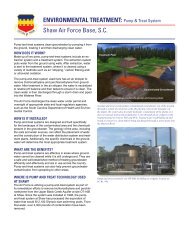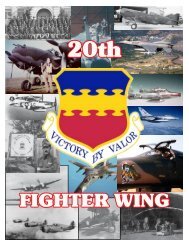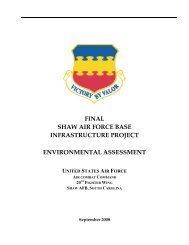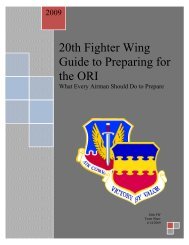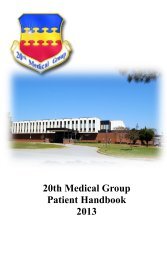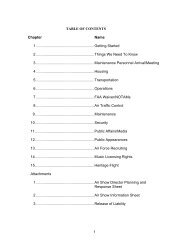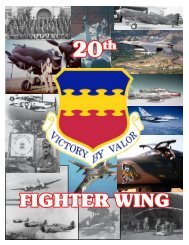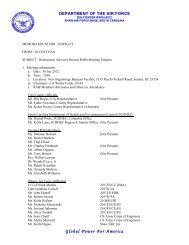HISTORY OF THE 20 FIGHTER GROUP - Shaw Air Force Base
HISTORY OF THE 20 FIGHTER GROUP - Shaw Air Force Base
HISTORY OF THE 20 FIGHTER GROUP - Shaw Air Force Base
You also want an ePaper? Increase the reach of your titles
YUMPU automatically turns print PDFs into web optimized ePapers that Google loves.
Subordinancy to the Fourteenth <strong>Air</strong> <strong>Force</strong> was short lived. On 1 August 1950 the wing was reassigned directly under<br />
Tactical <strong>Air</strong> Command. Ninth <strong>Air</strong> <strong>Force</strong> resumed control over the <strong>20</strong> th on 22 January 1951. Control was swapped back to<br />
Tactical <strong>Air</strong> Command on 1 December 1951, just after the wing’s relocation from <strong>Shaw</strong> to Langley AFB, Virginia. At<br />
Langley, the wing began flying new Republic F-84Gs in addition to F-84Ds. An internal change during the wing’s short<br />
stay at <strong>Shaw</strong> Field featured the 3 November 1949 inactivation of the <strong>20</strong> th Finance Disbursing Unit.<br />
The <strong>20</strong> th Goes Nuclear<br />
The <strong>20</strong> th FBW moved to Langley AFB, Virginia on 19 September 1951.<br />
Earlier a cadre of seven members of the <strong>20</strong> th had spent time at Langley<br />
secretly learning the ins and outs of nuclear weapons delivery. There they<br />
worked out procedures for accomplishing this using their soon to be assigned<br />
F-84Gs. One big hurdle would be to develop procedures for navigation to the<br />
target, on average 700 miles, without navigation aids of any kind with the<br />
exception of the compass. With the <strong>20</strong> th ’s move to Langley the procedures<br />
developed by the initial cadre would be passed on to the rest of the wing. As<br />
told by Col. George M. Lunsford USAF (Ret), Col. Dunning said we would be<br />
the world’s first atomic fighter outfit. We’d move up to Langley in the autumn<br />
of ‘51, pick up more than a hundred new airplanes, and reorganize<br />
completely. We’d learn to drop that [darn] bomb and get away. And we would<br />
do it all by the spring of ‘52 because we were going back to England again.<br />
In true <strong>20</strong> th tradition they became fully trained in this new mission and the <strong>20</strong> th<br />
moved to England to add to the growing deterrent of Soviet aggression.<br />
Move to Wethersfield May 1952<br />
The <strong>20</strong> th FBW made its second move, this time overseas to RAF Wethersfield in Essex, England, on 1 June 1952. Its<br />
fighter bomber group set up headquarters, along with the 55 th and 77 th<br />
FBSs, at Wethersfield a day later. Restricted space there compelled the<br />
79 th FBS to move into RAF Bentwaters in Suffolk, England, on the same<br />
day. (The squadron moved to RAF Woodbridge, three miles southeast of<br />
Bentwaters, on 1 October 1954.) On 5 June, Tactical <strong>Air</strong> Command<br />
relinquished control over the wing to the Third <strong>Air</strong> <strong>Force</strong> and the United<br />
States <strong>Air</strong> <strong>Force</strong>s in Europe.<br />
<strong>20</strong> FBW F-84G aircraft at Bluie West One, Greenland<br />
heading to England Summer 1952.<br />
On 15 November 1952, the wing and group merged their headquarters<br />
through internal reorganization, thus unofficially dissolving the group and<br />
placing the flying squadrons directly under the wing’s operational and<br />
administrative control. The group remained on the <strong>Air</strong> <strong>Force</strong>’s active list<br />
however, until 8 February 1955 when the three fighter bomber squadrons<br />
were officially realigned under the wing.<br />
Wing Bestowed With Group’s Heritage<br />
The Department of the <strong>Air</strong> <strong>Force</strong> temporarily bestowed the lineage<br />
and honors of the <strong>20</strong> th Group on the <strong>20</strong> th Wing in November 1954.<br />
That action was accomplished to facilitate the <strong>Air</strong> <strong>Force</strong>’s adoption of<br />
a wing base plan, making the wing the primary combat element of<br />
operational organizations. Consequent to the action of temporary<br />
bestowal, the <strong>20</strong> th FBW laid claim to the lineage, honors, and history<br />
of the <strong>20</strong> th FG. That bestowal has remained in effect ever since. The<br />
<strong>20</strong> th has been very fortunate to have kept its original squadrons<br />
throughout its history since the 79 th joined the 55 th and 77 th in 1933.<br />
As far as this historian has been able to determine the <strong>20</strong> th is the<br />
only unit to still have its original squadrons.<br />
In June 1955, the wing began flying F-84F Thunderstreaks in<br />
addition to its F-84Ds and F-84Gs. The F-84G was phased out by<br />
June 1955 and the F-84F remained in the inventory until December<br />
1957.<br />
Nuclear capable F-84G of the 55th Fighter Bomber<br />
Squadron at RAF Wethersfield, England.<br />
F-84F of the 77th FBS at RAF Wethersfield. Photo by R. L. Ward



